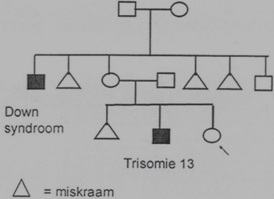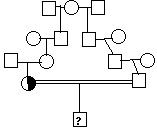What will be the proportion of the live-born children
Question 1) In a family with familial breast cancer, a BRCA1 mutation has been identified in the index case, a women of 51 years old with breast cancer. Her daughter of 27 is not affected, but is willing to take predictive testing. As a clinical geneticist, what would you certainly discuss with this daughter.
Question 2) Myotonic Dystrophy is a Mendelian disorder, but the clinical phenotype is not exactly caused by a defect in a single gene. Please explain.
Also, why does the disease present with a severe congenital myotonic dystrophy in one generation, and cataract as the only presenting symptom in another generation ?
Question 3) What would be the risk for the girl in this family (and for her children) for a recurrence of the defects that have previously been observed in her family. Her uncle has Down syndromeand her brother died with trisomy 13

(miskraam = miscarriage)
Question 1. A husband and wife both have the same autosomal dominant disease. The disease is viable in a heterozygous status, but lethal in utero (prenatally) in homozygotes. In addition, in the heterozygous state, the penetrance is only 50%. What will be the proportion of the live-born children with the disease ?
A 1 in 2
B 2 in 3
C 1 in 3
D 1 in 4
E all children will be affected.
Question 2. A women is a carrier of a mutation for a very rare disease (for instance, an inborn, recessive glycosylation disorder). Her partner is her second cousin (see family tree). What is the risk that the child has this disease ?

A 1 in 2
B 1 in 4
C 1 in 16
D 1 in 64
E 1 in 256
Question 3. Hemochromatosis is a frequent, autosomal recessive disorder which causes iron overload. The gene frequency is approx. 1 in 20 in our country. If the penetrance of the genotype for the disease is 0.2 in women, what would be the expected incidence of the disease in this half of the population ?
A 1 in 20
B 1 in 40
C 1 in 200
D 1 in 400
E 1 in 2000
Question 4. Which of these conditions only affects boys ?
A Down syndrome
B Trisomy 13
C Trisomy 18
D Klinefelter syndrome
E Turner syndrome
Question 5. So far, only 2 genes (BRCA1 en BRCA2) are known to cause an autosomal dominant predisposition to breast cancer. This is an example of:
A Linkage
B Allelicheterogeneity
C Geneticheterogeneity
D A multifactorial disease
E. A “founder” effect
Question 6. A population study, using a direct DNA test, has indicated that 1 in 100 individualsare carriers of a deletion in the SMN1-gene, responsible for spinal muscular atrophy (SMA, an autosomal recessive disease). What is the frequency of the disease that would you expect in this population ?
A 1 in 100
B 1 in 400
C 1 in 2000
D 1 in 10000
E 1 in 40000
Question 7. Which of the following situations has the lowest occurrence risk for trisomy 13?
A Advanced age in the mother.
B The mother carries a 13/14 Robertsoniantranslocation.
C The father carries a 13/14 Robertsonian translocation.
D There is a germ line mosaicism in the mother for47,XX,+13.
E Advanced age in the father.
Question 8. A 15 bp duplication in exon 14 of the NF1 gene would result in
A a missensemutation
B a stopmutation
C a frame-shift mutation
D a splice mutation
E an in-frame shift in the reading frame for translation
Question 9. Which of the following statements is NOT true ?
A In marriages between first cousins, the risk for a recessive disease is increased.
B Hemophilia A is caused by mutations in the factor VIII gene.
C Sisters of patients with Duchenne muscular dystrophy are always carriers.
D Germ line mosaicism increases the recurrence risk for achondroplasia in the normal parents of a patient.
E Thanks to the introduction of recombinant FVIII protein, the risk for an accidental infection with HIV has decreased in patients with haemophilia A.
Question 10. In which of the following cases would a chorionic villus sampling (CVS) be advised ?
A The previous child has a chromosomal disorder.
B One of the parents carries a mutation in the cystic fibrosis gene.
C Both parents have a manic depressive illness.
D The maternal age is 35.
E The previous child has a neural tube defect (spina bifida).
